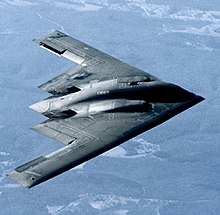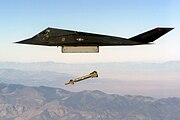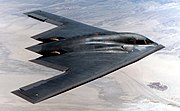During World War I, an attempt to reduce the visibility of military aircraft resulted in the German heavy bomber, the Linke-Hofmann R.I; this had a wooden structure covered with transparent material. The first true "stealth" aircraft may have been the Horten Ho 229 flying wing fighter-bomber, developed in Germany during the last years of World War II. In addition to the aircraft's shape, which may not have been a deliberate attempt to affect radar deflection, the majority of the Ho 229's wooden skin was bonded together using carbon-impregnated plywood resins designed with the purported intention of absorbing radar waves. Testing performed in early 2009 by the Northrop-Grumman Corporation established that this compound, along with the aircraft's shape, would have rendered the Ho 229 virtually invisible to Britain's Chain Home early warning radar, provided the aircraft was traveling at high speed (approximately 550 mph (890 km/h)) at extremely low altitude (50–100 feet).
In the closing weeks of WWII the US military initiated "Operation Paperclip", an effort by the US Army to capture as much advanced German weapons research as possible, and also to deny that research to advancing Soviet troops. A Horton glider and the Ho 229 number V3 were secured and sent to Northrop Aviation for evaluation in the United States, who much later used a flying wing design for the B-2 stealth bomber. During WWII Northrop had been commissioned to develop a large wing-only long-range bomber (XB-35) based on photographs of the Horton's record-setting glider from the 1930s, but their initial designs suffered controllability issues that were not resolved until after the war. Northrop's small one-man prototype (N9M-B) and a Horton wing-only glider are located in the Chino Air Museum in Southern California.
Modern stealth aircraft first became possible when Denys Overholser, a mathematician working for Lockheed Aircraft during the 1970s, adopted a mathematical model developed by Petr Ufimtsev, a Russian scientist, to develop a computer program called Echo 1. Echo made it possible to predict the radar signature an aircraft made with flat panels, called facets. In 1975, engineers at Lockheed Skunk Works found that an aircraft made with faceted surfaces could have a very low radar signature because the surfaces would radiate almost all of the radar energy away from the receiver. Lockheed built a model called "the Hopeless Diamond", so-called because it resembled a squat diamond, and looked too hopeless to ever fly. Because advanced computers were available to control the flight of even a Hopeless Diamond, for the first time designers realized that it might be possible to make an aircraft that was virtually invisible to radar.
Reduced radar cross section is only one of five factors the designers addressed to create a truly stealthy design such as the F-22. The F-22 has also been designed to disguise its infrared emissions to make it harder to detect by infrared homing ("heat seeking") surface-to-air or air-to-air missiles. Designers also addressed making the aircraft less visible to the naked eye, controlling radio transmissions, and noise abatement.
The first combat use of purpose-designed stealth aircraft was in December 1989 during Operation Just Cause in Panama. On 20 December 1989, two USAF F-117s bombed a Panamanian Defense Force barracks in Rio Hato, Panama. In 1991, F-117s were tasked with attacking the most heavily fortified targets in Iraq in the opening phase of Operation Desert Storm and were the only jets allowed to operate inside Baghdad's city limits.
General Design
The general design of a Stealth Aircraft is always aimed at reducing radar and thermal detection. It is the designer's top priority to satisfy the following conditions some of which are listed below by using his skills which ultimately decides the success of the aircraft:-
- Reducing thermal emission from thrust
- Reducing radar detection by altering some general configuration (like introducing the split rudder)
- Reducing radar detection when the aircraft opens its weapons bay
Limitations

Instability of design
Early stealth aircraft were designed with a focus on minimal radar cross section (RCS) rather than aerodynamic performance. Highly-stealth aircraft like the F-117 Nighthawk are aerodynamically unstable in all three axes and require constant flight corrections from a fly-by-wire (FBW) flight system to maintain controlled flight. Most modern non-stealth fighter aircraft are unstable on one or two axes only. However, in the pursuit of increased maneuverability, most 4th and 5th-generation fighter aircraft have been designed with some degree of inherent instability that must be controlled by fly-by-wire computers. As for the B2 Spirit, based on the development of the all-wing aircraft by Jack Northrop since 1940, design allowed creating stable aircraft with sufficient yaw control, even without vertical surfaces such as rudders.
Dogfighting ability
Earlier stealth aircraft (such as the F-117 and B-2) lack afterburners, because the hot exhaust would increase their infrared footprint, and breaking the sound barrier would produce an obvious sonic boom, as well as surface heating of the aircraft skin which also increased the infrared footprint. As a result their performance in air combat maneuvering required in a dogfight would never match that of a dedicated fighter aircraft. This was unimportant in the case of these two aircraft since both were designed to be bombers. More recent design techniques allow for stealthy designs such as the F-22 without compromising aerodynamic performance. Newer stealth aircraft, like the F-22, F-35 and the Sukhoi T-50, have performance characteristics that meet or exceed those of current front-line jet fighters due to advances in other technologies such as flight control systems, engines, airframe construction and materials.
Electromagnetic emissions
The high level of computerization and large amount of electronic equipment found inside stealth aircraft are often claimed to make them vulnerable to passive detection. This is highly unlikely and certainly systems such as Tamara and Kolchuga, which are often described as counter-stealth radars, are not designed to detect stray electromagnetic fields of this type. Such systems are designed to detect intentional, higher power emissions such as radar and communication signals. Stealth aircraft are deliberately operated to avoid or reduce such emissions.
Current Radar Warning Receivers look for the regular pings of energy from mechanically swept radars while fifth generation jet fighters use Low Probability of Intercept Radars with no regular repeat pattern.
Vulnerable modes of flight
Stealth aircraft are still vulnerable to detection during, and immediately after using their weaponry. Since stealth payload (reduced RCS bombs and cruise missiles) are not yet generally available, and ordnance mount points create a significant radar return, stealth aircraft carry all armament internally. As soon as weapons bay doors are opened, the plane's RCS will be multiplied and even older generation radar systems will be able to locate the stealth aircraft. While the aircraft will reacquire its stealth as soon as the bay doors are closed, a fast response defensive weapons system has a short opportunity to engage the aircraft.
This vulnerability is addressed by operating in a manner that reduces the risk and consequences of temporary acquisition. The B-2's operational altitude imposes a flight time for defensive weapons that makes it virtually impossible to engage the aircraft during its weapons deployment. All stealthy aircraft carry weapons in internal weapons bays. New stealth aircraft designs such as the F-22 and F-35 can open their bays, release munitions and return to stealthy flight in less than a second.
Some weapons require that the weapon's guidance system acquire the target while the weapon is still attached to the aircraft. This forces relatively extended operations with the bay doors open.
Also, such aircraft as the F-22 Raptor and F-35 Lighting II Joint Strike Fighter can also carry additional weapons and fuel on hardpoints below their wings. When operating in this mode the planes will not be nearly as stealthy, as the hardpoints and the weapons mounted on those hardpoints will show up on radar systems. This option therefore represents a trade off between stealth or range and payload. External stores allow those aircraft to attack more targets further away, but will not allow for stealth during that mission as compared to a shorter range mission flying on just internal fuel and using only the more limited space of the internal weapon bays for armaments.
Reduced payload

Fully stealth aircraft carry all fuel and armament internally, which limits the payload. By way of comparison, the F-117 carries only two laser or GPS guided bombs, while a non-stealth attack aircraft can carry several times more. This requires the deployment of additional aircraft to engage targets that would normally require a single non-stealth attack aircraft. This apparent disadvantage however is offset by the reduction in fewer supporting aircraft that are required to provide air cover, air-defense suppression and electronic counter measures, making stealth aircraft "force multipliers".
Sensitive skin
The B-2 has a skin made with highly specialized materials such as Polygraphite.
Cost of operations
Stealth aircraft are typically more expensive to develop and manufacture. An example is the B-2 Spirit that is many times more expensive to manufacture and support than conventional bomber aircraft. The B-2 program cost the U.S. Air Force almost $45 billion.
Detection
Theoretically there are a number of methods to detect stealth aircraft at long range.
Reflected waves
Passive (multistatic) radar, bistatic radar[19] and especially multistatic radar systems are believed to detect some stealth aircraft better than conventional monostatic radars, since first-generation stealth technology (such as the F117) reflects energy away from the transmitter's line of sight, effectively increasing the radar cross section (RCS) in other directions, which the passive radars monitor. Such a system typically uses either low frequency broadcast TV and FM radio signals (at which frequencies controlling the aircraft's signature is more difficult). Later stealth approaches do not rely on controlling the specular reflections of radar energy and so the geometrical benefits are unlikely to be significant.
Researchers at the University of Illinois at Urbana-Champaign with support of DARPA, have shown that it is possible to build a synthetic aperture radar image of an aircraft target using passive multistatic radar, possibly detailed enough to enable automatic target recognition (ATR).
In December 2007, SAAB researchers also revealed details for a system called Associative Aperture Synthesis Radar (AASR) that would employ a large array of inexpensive and redundant transmitters and a few intelligent receivers to exploit forward scatter to detect low observable targets. The system was originally designed to detect stealthy cruise missiles and should be just as effective against aircraft. The large array of inexpensive transmitters also provides a degree of protection against anti-radar (or anti-radiation) missiles or attacks.
Infrared (heat)
Some analysts claim Infra-red search and track systems (IRSTs) can be deployed against stealth aircraft, because any aircraft surface heats up due to air friction and with a two channel IRST is a CO2 (4.3 µm absorption maxima) detection possible, through difference comparing between the low and high channel. These analysts also point to the resurgence in such systems in several Russian designs in the 1980s, such as those fitted to the MiG-29 and Su-27. The latest version of the MiG-29, the MiG-35, is equipped with a new Optical Locator System that includes even more advanced IRST capabilities.
In air combat, the optronic suite allows:
- Detection of non-afterburning targets at 45-kilometre (28 mi) range and more;
- Identification of those targets at 8-to-10-kilometre (5.0 to 6.2 mi) range; and
- Estimates of aerial target range at up to 15 kilometres (9.3 mi).
For ground targets, the suite allows:
- A tank-effective detection range up to 15 kilometres (9.3 mi), and aircraft carrier detection at 60 to 80 kilometres (37 to 50 mi);
- Identification of the tank type on the 8-to-10-kilometre (5.0 to 6.2 mi) range, and of an aircraft carrier at 40 to 60 kilometres (25 to 37 mi); and
- Estimates of ground target range of up to 20 kilometres (12 mi).
Wavelength match
The Dutch company Thales Nederland, formerly known as Holland Signaal, have developed a naval phased-array radar called SMART-L, which also is operated at L-Band and is claimed to offer counter stealth benefits. However, as with most claims of counter-stealth capability, these are unproven and untested. True resonant effects might be expected with HF sky wave radar systems, which have wavelengths of tens of metres. However, in this case, the accuracy of the radar systems is such that the detection is of limited value for engagement. Any radar which can successfully match the resonant frequency of a type of stealth aircraft should be able to detect its direction. In practice this is difficult because the resonant frequency changes depending on how the stealth aircraft is oriented with respect to the radar system.
OTH radar (over-the-horizon radar)
Over-the-horizon radar is a design concept that increases radar's effective range over conventional radar. It is claimed that the Australian JORN Jindalee Operational Radar Network can overcome certain stealth characteristics. It is claimed that the HF frequency used and the method of bouncing radar from ionosphere overcomes the stealth characteristics of the F-117A. In other words, stealth aircraft are optimized for defeating much higher-frequency radar from front-on rather than low-frequency radars from above.
Operational usage of stealth aircraft


Stealth aircraft have been used in several conflicts: the United States invasion of Panama, the Gulf War, the Kosovo Conflict, the War in Afghanistan the War in Iraq and the 2011 military intervention in Libya. To date, the United States of America is the only country to have used stealth aircraft in combat.
The first use of stealth aircraft was in the United States invasion of Panama, where F-117 Nighthawk stealth attack aircraft were used to drop bombs on enemy airfields and positions while evading enemy radars.
The successful first deployment of stealth aircraft to a combat zone marks a milestone in military aviation.
In 1990 the F-117 Nighthawk was used again in the Gulf War, where F-117s flew approximately 1,300 sorties and scored direct hits on 1,600 high-value targets in Iraq while accumulating over 6,905 flight hours. Only 2.5% of the American aircraft in Iraq were F-117s, yet they struck more than 40% of the strategic targets, dropping over 2,000 tons of precision-guided munitions and striking their targets with over an 80% success rate.
In the 1999 NATO bombing of Yugoslavia two stealth aircraft were used by the United States, the veteran F-117 Nighthawk, and the newly introduced B-2 Spirit strategic stealth bomber.
The F-117 performed its usual role of striking precision high-value targets and performed well, although one F-117 was shot down by a Serbian Isayev S-125 'Neva-M' missile commanded by Colonel Zoltán Dani. The new B-2 Spirit was highly successful, destroying 33% of selected Serbian bombing targets in the first eight weeks of U.S. involvement in the War. During this war, B-2s flew non-stop to Kosovo from their home base in Missouri and back.
In the 2003 invasion of Iraq, F-117 Nighthawks and B-2 Spirits were again used, and this was the last time the F-117 would see combat.
F-117s dropped satellite-guided strike munitions on selected targets, with high success. B-2 Spirits conducted 49 sorties in the invasion, releasing more than 1.5 million pounds of munitions.
During the May 2011 operation to kill Osama bin Laden, one of the helicopters used to clandestinely insert US troops into Pakistan crashed in the bin Laden compound. From the wreckage it was revealed that this helicopter had stealth characteristics, making this the first publically-known operational use of a stealth helicopter.
The most recent use of stealth aircraft was in the 2011 military intervention in Libya, where B-2 Spirits dropped 40 bombs on a Libyan airfield with concentrated air defenses in support of the UN no-fly zone.


In the future, it is likely that stealth aircraft will continue to play a valuable role in air combat. In future conflicts the United States is likely to use the F-22 Raptor, B-2 Spirit, and the F-35 Lightning II to perform a variety of operations.
In Russia, the Sukhoi PAK FA stealth multi-role fighter is scheduled to be introduced from 2015, to perform a wide variety of missions. In India, the Sukhoi/HAL FGFA, the Indian version of the PAK FA is scheduled to be introduced from 2017 in higher numbers, also to perform a wide variety of missions.
In the People's Republic of China, the Chengdu J-20 stealth multi-role fighter is planned to be introduced around 2018. A prototype was flown in early 2011.
No comments:
Post a Comment